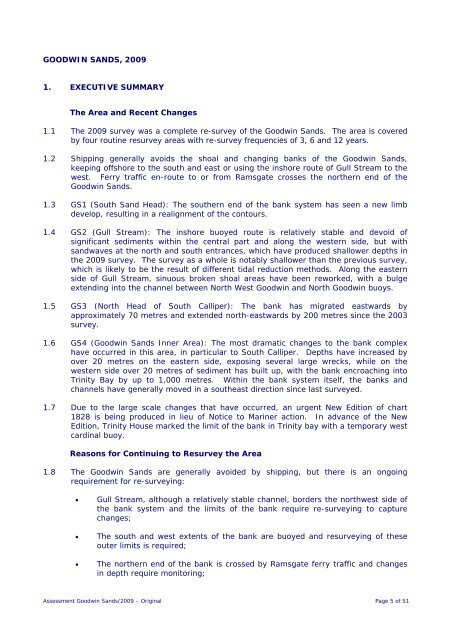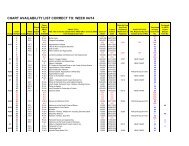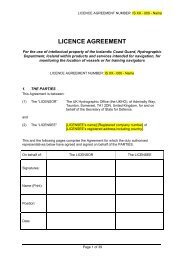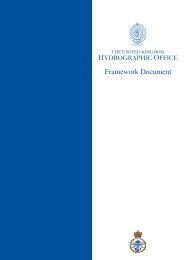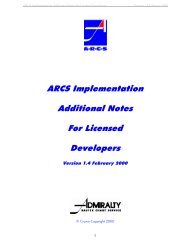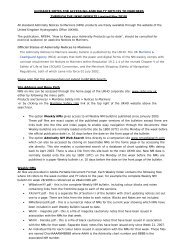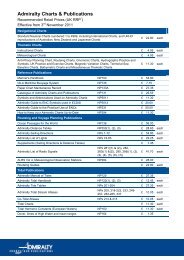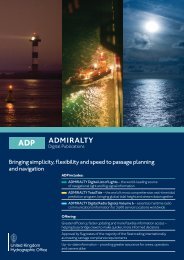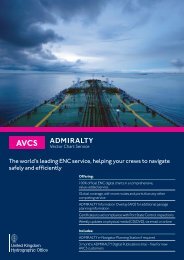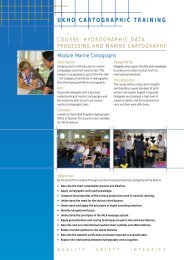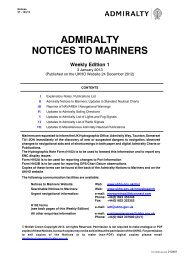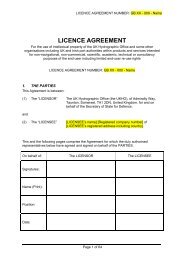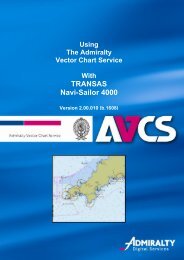GS1-2-3-4 Goodwin Sands - United Kingdom Hydrographic Office
GS1-2-3-4 Goodwin Sands - United Kingdom Hydrographic Office
GS1-2-3-4 Goodwin Sands - United Kingdom Hydrographic Office
You also want an ePaper? Increase the reach of your titles
YUMPU automatically turns print PDFs into web optimized ePapers that Google loves.
GOODWIN SANDS, 2009<br />
1. EXECUTIVE SUMMARY<br />
The Area and Recent Changes<br />
1.1 The 2009 survey was a complete re-survey of the <strong>Goodwin</strong> <strong>Sands</strong>. The area is covered<br />
by four routine resurvey areas with re-survey frequencies of 3, 6 and 12 years.<br />
1.2 Shipping generally avoids the shoal and changing banks of the <strong>Goodwin</strong> <strong>Sands</strong>,<br />
keeping offshore to the south and east or using the inshore route of Gull Stream to the<br />
west. Ferry traffic en-route to or from Ramsgate crosses the northern end of the<br />
<strong>Goodwin</strong> <strong>Sands</strong>.<br />
1.3 <strong>GS1</strong> (South Sand Head): The southern end of the bank system has seen a new limb<br />
develop, resulting in a realignment of the contours.<br />
1.4 GS2 (Gull Stream): The inshore buoyed route is relatively stable and devoid of<br />
significant sediments within the central part and along the western side, but with<br />
sandwaves at the north and south entrances, which have produced shallower depths in<br />
the 2009 survey. The survey as a whole is notably shallower than the previous survey,<br />
which is likely to be the result of different tidal reduction methods. Along the eastern<br />
side of Gull Stream, sinuous broken shoal areas have been reworked, with a bulge<br />
extending into the channel between North West <strong>Goodwin</strong> and North <strong>Goodwin</strong> buoys.<br />
1.5 GS3 (North Head of South Calliper): The bank has migrated eastwards by<br />
approximately 70 metres and extended north-eastwards by 200 metres since the 2003<br />
survey.<br />
1.6 GS4 (<strong>Goodwin</strong> <strong>Sands</strong> Inner Area): The most dramatic changes to the bank complex<br />
have occurred in this area, in particular to South Calliper. Depths have increased by<br />
over 20 metres on the eastern side, exposing several large wrecks, while on the<br />
western side over 20 metres of sediment has built up, with the bank encroaching into<br />
Trinity Bay by up to 1,000 metres. Within the bank system itself, the banks and<br />
channels have generally moved in a southeast direction since last surveyed.<br />
1.7 Due to the large scale changes that have occurred, an urgent New Edition of chart<br />
1828 is being produced in lieu of Notice to Mariner action. In advance of the New<br />
Edition, Trinity House marked the limit of the bank in Trinity bay with a temporary west<br />
cardinal buoy.<br />
Reasons for Continuing to Resurvey the Area<br />
1.8 The <strong>Goodwin</strong> <strong>Sands</strong> are generally avoided by shipping, but there is an ongoing<br />
requirement for re-surveying:<br />
• Gull Stream, although a relatively stable channel, borders the northwest side of<br />
the bank system and the limits of the bank require re-surveying to capture<br />
changes;<br />
• The south and west extents of the bank are buoyed and resurveying of these<br />
outer limits is required;<br />
• The northern end of the bank is crossed by Ramsgate ferry traffic and changes<br />
in depth require monitoring;<br />
Assessment <strong>Goodwin</strong> <strong>Sands</strong>/2009 – Original Page 5 of 51


